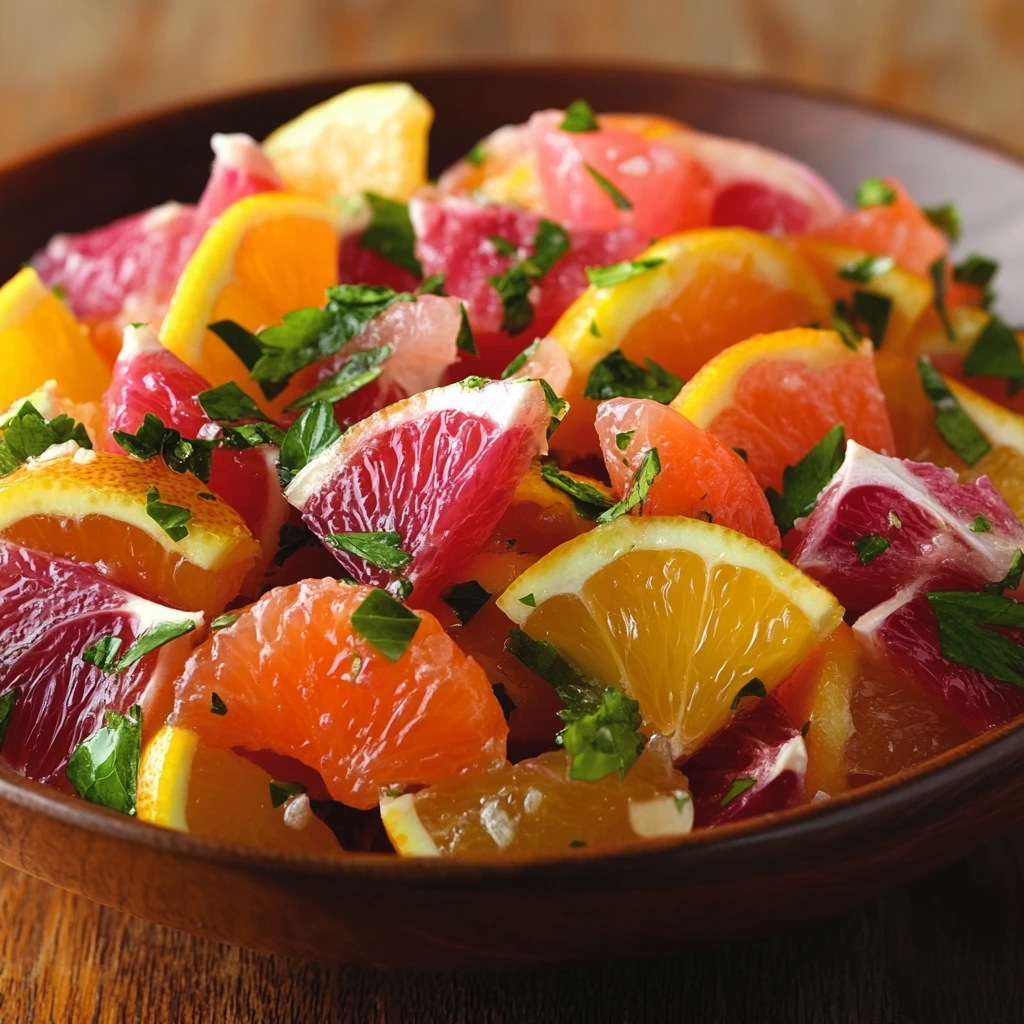Best Citrus Salad Recipe
A vibrant citrus salad is the perfect way to brighten up any meal, especially during the colder months when these fruits are at their peak. This refreshing combination of sweet, tangy citrus fruits, complemented by a light honey dressing and crunchy accents, makes for a dish that’s as nutritious as it is delicious. Whether you’re looking for a light lunch, a stunning side dish, or a refreshing dessert alternative, this versatile citrus salad recipe is guaranteed to impress.
Table of Contents
Why You’ll Love This Citrus Salad
This citrus salad recipe stands out from other fruit salads for several compelling reasons. First, it’s extraordinarily versatile – perfect as a light breakfast, a palate-cleansing side dish, or even a refreshing dessert when topped with a scoop of vanilla yogurt or a drizzle of honey.
The vibrant colors of the various citrus fruits create a visually stunning presentation that’s sure to impress guests at any gathering. The combination of sweet, tangy, and slightly bitter notes creates a complex flavor profile that keeps your taste buds engaged with every bite.
What’s more, this salad is incredibly healthy, packed with vitamin C, antioxidants, and fiber while remaining naturally low in calories. It’s also incredibly simple to prepare, requiring minimal cooking skills while delivering maximum impact.
The recipe is highly adaptable to seasonal availability and personal preferences – you can easily substitute different types of citrus fruits depending on what’s available at your local market. And for those with dietary restrictions, this citrus salad is naturally gluten-free, dairy-free, and vegan (when using maple syrup instead of honey).
Preparation Time and Yield
- Preparation Time: 20 minutes
- Total Time: 20 minutes (plus optional 30 minutes chilling time)
- Yield: 4-6 servings
This citrus salad comes together quickly, with most of the preparation time spent on peeling and segmenting the fruit. If you’re new to supreming citrus (removing the segments from the membranes), it might take a bit longer at first, but your speed will improve with practice.

Nutritional Information (Per Serving)
Based on 6 servings:
- Calories: 120
- Total Fat: 0.5g
- Sodium: 2mg
- Carbohydrates: 30g
- Fiber: 6g
- Sugar: 22g (all natural from fruit and minimal honey)
- Protein: 2g
- Vitamin C: 130% of daily recommended intake
- Calcium: 6% of daily recommended intake
- Potassium: 8% of daily recommended intake
Ingredients

The beauty of this citrus salad lies in its carefully balanced combination of sweet, tart, and slightly bitter citrus varieties. Here’s what you’ll need:
- 2 large navel oranges – Provide a sweet, familiar foundation with their reliable sweetness and juiciness
- 2 blood oranges – Add dramatic color and a berry-like flavor complexity
- 2 pink grapefruits – Contribute pleasant bitterness and tartness to balance the sweeter elements
- 3 mandarin oranges or clementines – Offer concentrated sweetness and a different texture
- 1 large cara cara orange – Brings a unique pink hue and sweet-tart flavor
- 1 lime – Used primarily for zest and juice in the dressing
- 2 tablespoons high-quality honey – Ties the flavors together with gentle sweetness
- 1 tablespoon fresh mint leaves, finely chopped – Adds a refreshing aromatic note
- 1 tablespoon fresh lime juice – Provides acidity to balance the sweetness
- 1/2 teaspoon vanilla extract (optional) – Adds depth to the dressing
- 1/4 cup pomegranate arils – For jewel-like color contrast and texture
- 2 tablespoons pistachios, roughly chopped – Contributes crunch and subtle nuttiness
- Pinch of flaky sea salt – Enhances and balances all flavors
The combination of different citrus varieties creates a complex flavor profile and striking visual appeal. For best results, select fruits that feel heavy for their size and have firm, unblemished skin, indicating juiciness and freshness.
Step-by-Step Instructions
- Prepare the citrus fruits: Working with one fruit at a time, use a sharp knife to cut off the top and bottom of each citrus fruit, exposing the flesh. Stand the fruit on one of the flat ends and carefully cut away the peel and white pith in strips, following the curve of the fruit. Once peeled, hold the fruit over a bowl to catch juices and cut along both sides of each membrane to release the segments (this technique is called “supreming”).
- Make the dressing: In a small bowl, whisk together the honey, fresh lime juice, lime zest, vanilla extract (if using), and a tiny pinch of salt until well combined.
- Assemble the salad: Arrange the citrus segments in a shallow serving bowl or platter, mixing the varieties for a beautiful color display. Alternatively, for a more elegant presentation, arrange them in overlapping patterns.
- Add finishing touches: Drizzle the honey-lime dressing over the arranged citrus segments. Sprinkle with the chopped mint, pomegranate arils, and chopped pistachios.
- Season and rest: Add a final light sprinkle of flaky sea salt to enhance all flavors. For best results, let the salad rest in the refrigerator for 30 minutes before serving to allow the flavors to meld.
- Serve: Bring to room temperature for about 10 minutes before serving to maximize flavor.
Ingredient Background
Understanding your ingredients helps create a more thoughtful and delicious citrus salad:
Citrus Varieties: Each citrus type brings unique characteristics to the salad. Blood oranges, with their dramatic ruby color, offer berry-like notes. Cara cara oranges have a sweet-tart profile with hints of cranberry. Grapefruits contribute pleasant bitterness and complexity, while mandarins add concentrated sweetness.
Honey: Select a light-flavored honey that won’t overpower the delicate citrus flavors. Acacia, orange blossom, or clover honey works particularly well with this salad.
Mint: Fresh mint adds a cooling counterpoint to the acidic citrus. The aromatic oils in mint help to tie together all the flavor components in the salad.
Pomegranate: Beyond their visual appeal, pomegranate arils add bursts of sweet-tart juice and a pleasant textural contrast to the soft citrus segments.
Pistachios: These nuts contribute not only crunch but also a subtle buttery flavor that complements the bright citrus notes. Their green color also enhances the salad’s visual appeal.
Technique Tips
Mastering a few key techniques will elevate your citrus salad from good to exceptional:
Supreming Citrus: This technique of removing the membrane from citrus segments creates a more elegant presentation and eliminates the tough, sometimes bitter membranes. Use a sharp paring knife and work over a bowl to catch the valuable juices, which can be incorporated into your dressing.
Balancing Flavors: The perfect citrus salad balances sweet, sour, bitter, and savory elements. If your fruit is particularly tart, add a bit more honey to the dressing. If overly sweet, increase the lime juice slightly.
Temperature Matters: Citrus fruits display their most complex flavors when served just slightly chilled rather than ice cold. Remove the salad from the refrigerator about 10 minutes before serving.
Cutting Board Technique: Place a damp paper towel or kitchen towel under your cutting board to prevent slipping while handling juicy citrus fruits.
Alternative Presentation Ideas
Transform this versatile citrus salad with these creative serving suggestions:
Citrus Carpaccio: Slice the peeled citrus fruits into thin rounds instead of segmenting them, and arrange in overlapping circles on a large platter. Drizzle with dressing and sprinkle with toppings for an artistic presentation.
Individual Servings: Present the salad in individual glass dishes or vintage coupe glasses for an elegant dinner party starter.
Composed Salad: Arrange the different citrus varieties in separate clusters rather than mixing them, creating a color-blocked effect.
Layered Parfait Style: In tall glasses, alternate layers of citrus segments with Greek yogurt sweetened with a touch of honey for a breakfast or dessert variation.
Citrus and Avocado Combination: For a more substantial dish, add sliced avocado to the salad and adjust the dressing with a touch of olive oil to create a savory-sweet combination.
Freezing and Storing
While citrus salad is best enjoyed fresh, there are ways to store it effectively:
Refrigeration: Store assembled citrus salad in an airtight container in the refrigerator for up to 24 hours. The flavors will continue to meld, though the texture may soften slightly.
Separate Components: For longer storage, keep the prepared citrus segments and dressing separate. The segmented fruit can be stored in an airtight container with its juices for up to 3 days, while the dressing will keep for up to 5 days.
Freezing Options: While the prepared salad doesn’t freeze well, you can freeze citrus segments for future use. Place supremed segments on a parchment-lined baking sheet, freeze until solid, then transfer to freezer bags. These can be used in smoothies or defrosted for other applications, though they will lose their firm texture.
Serving Suggestions for Events
This vibrant citrus salad makes a stunning addition to various occasions:
Brunch Gatherings: Serve alongside quiche or egg dishes for a refreshing counterpoint to savory breakfast items.
Dinner Parties: Present as a palate-cleansing intermezzo between courses or as a light starter.
Holiday Meals: The bright colors make this perfect for winter holiday tables when citrus is at its peak and a fresh element is welcome among heavier dishes.
Summer Barbecues: Offer as a cooling side dish alongside grilled meats or fish.
Wellness Retreats: Feature this nutrient-rich salad as part of a health-focused menu, perhaps with a yogurt drizzle instead of honey for added protein.
For larger events, prepare the components ahead of time but assemble just before serving for the freshest presentation.
Frequently Asked Questions (FAQs)
Can I make this citrus salad ahead of time? While it’s best enjoyed fresh, you can prepare the components up to 24 hours in advance. Segment the citrus fruits and store them in their juice in an airtight container. Prepare the dressing separately and combine everything just before serving.
Which citrus fruits work best in this salad? The beauty of this recipe is its flexibility. While the combination listed provides excellent flavor balance and visual appeal, you can use whatever citrus is available and in season. For best results, include at least three different varieties for complexity.
How do I select the best citrus for my salad? Choose fruits that feel heavy for their size, indicating juiciness. The skin should be firm, not soft or puffy, and have a pleasant fragrance when gently scratched.
Can I make this salad vegan? Yes! Simply substitute the honey with maple syrup or agave nectar for a fully vegan version.
What can I add to make this a more substantial meal? For a more filling dish, consider adding sliced avocado, a sprinkle of quinoa, or serving it alongside grilled chicken or fish. A handful of arugula or spinach can also transform it into a more traditional salad.
Why is my citrus bitter? Bitterness usually comes from including too much of the white pith. Take care to remove all the pith when peeling the fruit. If your grapefruit is particularly bitter, you can substitute it with additional oranges or sweeten the dressing slightly.
Conclusion
This vibrant citrus salad celebrates the natural beauty and flavor of seasonal citrus fruits in their prime. Far more than just a simple fruit salad, this thoughtfully composed dish balances sweet, tart, and subtly bitter notes with aromatic mint, crunchy pistachios, and jewel-like pomegranate seeds for a multi-dimensional sensory experience.
Perfect for brightening winter tables when citrus is at its peak or adding a refreshing element to summer meals, this versatile recipe can adapt to any occasion. The minimal preparation required belies the impressive impact this dish makes both visually and on the palate.
Whether you’re serving it as a light breakfast, an elegant first course, a palate-cleansing intermezzo, or a refreshing dessert alternative, this citrus salad delivers abundant flavor and nutrition in every bite. The combination of vitamin C, antioxidants, and fiber makes it as healthful as it is delicious.
With its stunning appearance and bright flavors, this best citrus salad recipe is sure to become a staple in your culinary repertoire, bringing a burst of sunshine to your table any time of year.







